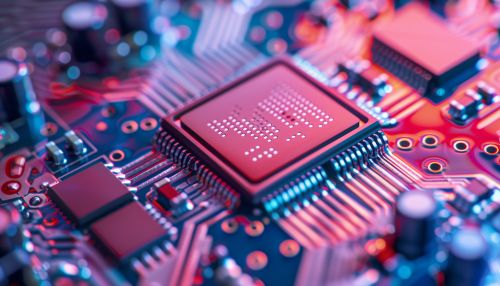Photodiodes
Introduction
A photodiode is a semiconductor device that converts light into an electrical current. The current is generated when photons are absorbed in the photodiode. Photodiodes are similar to regular semiconductor diodes except that they may be either exposed to light or packaged with a window or optical fiber connection to allow light to reach the sensitive part of the device. They are used in a wide range of applications, from simple light detection to complex optical communication systems.
Principles of Operation
Photodiodes operate based on the principle of the photoelectric effect, where photons striking the semiconductor material generate electron-hole pairs. When the photodiode is reverse-biased, these electron-hole pairs are separated by the electric field, resulting in a photocurrent. The magnitude of the photocurrent is directly proportional to the intensity of the incident light.
Photovoltaic Mode
In photovoltaic mode, the photodiode generates a voltage when exposed to light. This mode is commonly used in solar cells. The generated voltage can be used to power electronic devices or charge batteries.
Photoconductive Mode
In photoconductive mode, the photodiode is reverse-biased, and the photocurrent is measured. This mode is more sensitive than photovoltaic mode and is used in applications requiring high-speed or high-sensitivity light detection.
Types of Photodiodes
Photodiodes come in various types, each suited for specific applications. The most common types include:
PIN Photodiodes
PIN photodiodes have an intrinsic layer between the p-type and n-type layers, which increases the depletion region and improves the device's sensitivity and speed. They are widely used in optical communication systems.
Avalanche Photodiodes (APDs)
Avalanche photodiodes operate with a high reverse bias, causing avalanche multiplication of the photocurrent. This results in higher sensitivity and gain, making APDs suitable for low-light-level detection and high-speed applications.
Schottky Photodiodes
Schottky photodiodes use a metal-semiconductor junction instead of a p-n junction. They offer fast response times and are used in high-speed and high-frequency applications.
MSM Photodiodes
Metal-Semiconductor-Metal (MSM) photodiodes have interdigitated metal contacts on the semiconductor surface. They provide high-speed response and are used in high-speed optical communication systems.
Materials and Fabrication
Photodiodes are fabricated using various semiconductor materials, each offering different properties and performance characteristics.
Silicon Photodiodes
Silicon is the most commonly used material for photodiodes due to its availability, cost-effectiveness, and suitable spectral response for visible and near-infrared light.
Germanium Photodiodes
Germanium photodiodes are used for infrared detection due to their sensitivity to longer wavelengths. They are commonly used in infrared spectroscopy and thermal imaging.
III-V Compound Photodiodes
III-V compound semiconductors, such as Gallium Arsenide (GaAs) and Indium Gallium Arsenide (InGaAs), offer high-speed performance and sensitivity to a wide range of wavelengths. They are used in high-speed optical communication and sensing applications.
Applications
Photodiodes are used in a wide range of applications, including:
Optical Communication
Photodiodes are integral components in optical communication systems, where they convert optical signals into electrical signals for data transmission and reception.
Light Detection and Ranging (LiDAR)
LiDAR systems use photodiodes to detect reflected laser light, enabling precise distance measurements and 3D mapping.
Medical Devices
Photodiodes are used in medical devices such as pulse oximeters and blood glucose monitors, where they detect light absorption changes in biological tissues.
Environmental Monitoring
Photodiodes are used in environmental monitoring systems to detect light levels, UV radiation, and other environmental parameters.
Consumer Electronics
Photodiodes are found in various consumer electronics, including remote controls, optical mice, and ambient light sensors in smartphones and tablets.
Performance Parameters
Several key parameters define the performance of photodiodes:
Responsivity
Responsivity is the ratio of the photocurrent generated to the incident light power. It is typically measured in amperes per watt (A/W) and varies with wavelength.
Dark Current
Dark current is the small current that flows through the photodiode in the absence of light. It is an important parameter in low-light applications, as it affects the signal-to-noise ratio.
Quantum Efficiency
Quantum efficiency is the ratio of the number of electron-hole pairs generated to the number of incident photons. It is a measure of the photodiode's effectiveness in converting light into electrical current.
Response Time
Response time is the time taken by the photodiode to respond to a change in light intensity. It is a critical parameter in high-speed applications.
Noise Equivalent Power (NEP)
NEP is the amount of incident light power required to produce a photocurrent equal to the noise current. It is a measure of the photodiode's sensitivity.
Future Developments
Research and development in photodiode technology continue to advance, with ongoing efforts to improve performance, sensitivity, and integration with other electronic components. Emerging materials, such as graphene and other 2D materials, offer promising potential for next-generation photodiodes with enhanced capabilities.
See Also
- Photoelectric Effect
- Optical Communication
- Light Detection and Ranging (LiDAR)
- Gallium Arsenide
- Graphene


